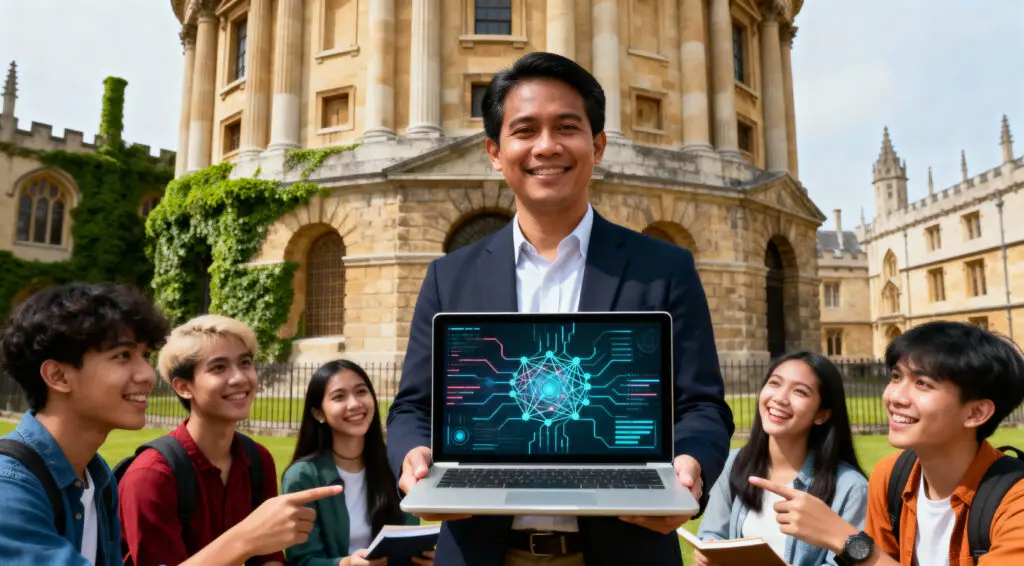A Filipino Educator’s Journey to Oxford
When Filipino artist and teacher Ruston Banal got an invitation to speak at Oxford University’s Artificial Intelligence in Education (AIEOU) program, he couldn’t believe it at first. His idea, “Image Design: Reversing AI,” is all about educating students on how to spot fraudulent pictures using creative and critical design methodologies.
After being turned down by schools in the Philippines for years, getting into Oxford was a sign that they were right and more significantly, it was a call to action to improve AI literacy and critical image education. For Banal, going to the conference was more than simply an academic honor; it was a mission to fight the rising problem of AI-driven fake news in the Philippines.

Inside Oxford’s AIEOU AI Learning Center
Dr. Sara Ratner is in charge of the AIEOU Hub, which is a multidisciplinary research project that is helping to shape the ethical use of AI in education. The Hub was started in 2024 to support a human-centered approach to AI by concentrating on four main areas: design, legislation, implementation, and effect.
Dr. Ratner said that Oxford’s job is to encourage conversation and cooperation among teachers from all around the world at a time when AI is questioning basic ideas about teaching and learning. There are already people from more than 100 nations in the AIEOU Hub, and they all provide different points of view to help construct responsible AI education frameworks.
Overcoming Barriers to Attend
Even though it was an honor to be invited, Banal’s trip to Oxford was not simple at all. It was almost hard to pay for a visa, travel, and a place to stay because of money problems. But the support of the community made the idea come true. Friends from the Philippines and other countries came together to pay for his trip, and mentors like Dadiyow Ric, who had been helping him for a long time, made it feasible for him to go.
When Banal got to Oxford, he was amazed by how big and intelligent the city was. From the Ashmolean Museum to St. John’s College, every step seemed like a sign that a Filipino teacher was entering the international stage of academic innovation and discussion.
Recommended Article: UNESCO, CANIETI Launch Ethical AI Model for Mexico
“Image Design” and Reversing AI Fakery
At the AIEOU Conference, Banal talked about image design, a way to combine creativity and critical thinking to fight false information. The strategy employs activities on smartphones that teach students how to replicate and break down AI-generated visuals, which lets them find out where the visual modification came from.
The program is divided into three main parts: production, consumption, and the mediating lens. Each part helps students learn how pictures are created, shared, and understood. The idea is to help people learn how to read and write in a world where algorithms spread false information.
Highlights from the AIEOU Conference
The event brought together leading researchers and innovators from MIT, UCLA, India, and Australia to talk about initiatives that are changing how AI is used in education. Some of them are:
- Huiwen Wang talked on the ACE Framework, which is about cognitive immunity and how to stop people from relying too much on AI by encouraging them to think for themselves.
- MyReports is an AI application created by Chris Hack and Niki Dinsey that turns instructors’ notes into polished reports. It saves teachers time and makes their jobs easier.
- Global Challenges, Local Voices is Dr. Ratner’s own initiative that uses AI to protect native languages. It includes tale translation models that encourage linguistic variety.
Each initiative showed that AI could help people learn instead of replacing them, which was a message that Banal strongly supported.
AI as a Co-Creator, Not a Threat
Banal says that AI is dangerous in the Philippines, where it may be used to spread false information and propaganda during elections. But instead of hating AI, he says we can consider technology like a co-creator, a partner that helps people learn and be creative when they are led by ethics and awareness.
He says that AI-generated content might be used to manipulate people if people don’t learn about it ahead of time. Image Design and other programs like it help Filipinos safeguard democracy online by teaching them how to think critically, check sources, and protect their rights.
The Philippine Response to AI Literacy
Back home, there is a growing interest in AI education. Miriam College is already teaching digital literacy, ethics, and prompt engineering in its classes. It is also working on a national AI strategy. Sofia Soledad DG De Guzman, a teacher, said that a new textbook called Effective Communication will include comprehensive chapters on AI integration by 2026.
These actions are the start of a long-term national effort to close the AI literacy gap and make sure that Filipino students are ready to use technology in a responsible and aware way.
A New Chapter for Filipino Creativity
Banal’s time at Oxford shows a very important truth: the Philippines can have a big impact on the global AI discourse. Filipino teachers can help change AI from a danger to a tool for societal progress and fairness by encouraging critical thinking and creative resilience.
As Oxford’s AIEOU Hub continues to flourish, it signifies more than research, it represents a shared future of ethical AI education, where collaboration between nations enables teachers and learners to lead with knowledge, empathy, and truth.























